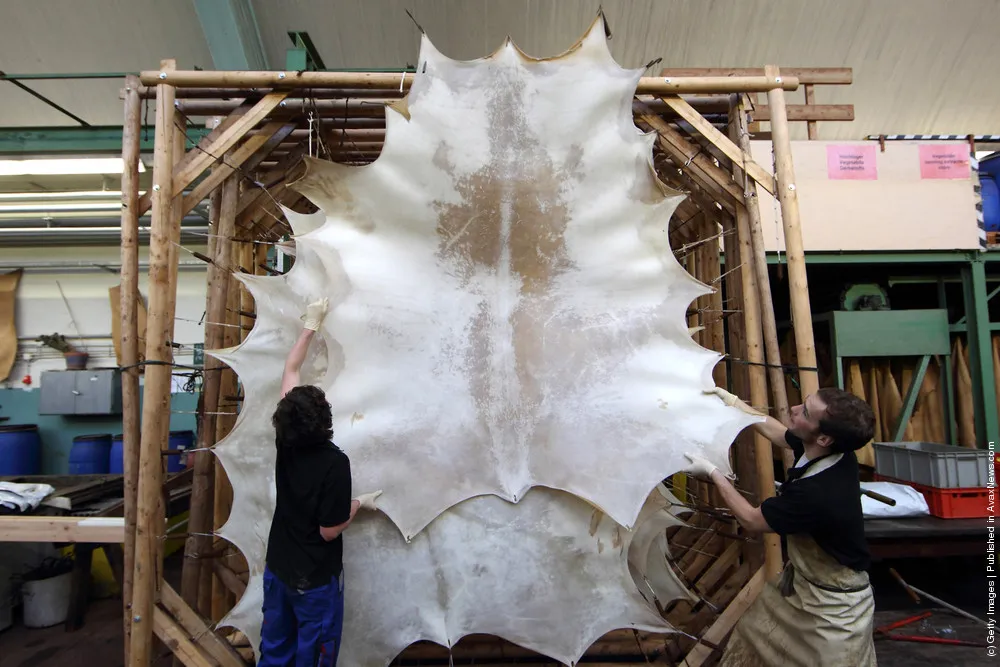|
REUTLINGEN, GERMANY - NOVEMBER 17: Students hang out finished parchment leather at the LGR (Lederinstitut Gerberschule Reutlingen) tannery school on November 17, 2010 in Reutlingen, Germany. Even in early antiquity and up their hair or dried goat and sheep skins were used as material for documents. In the small Asian city Pergamon these skins were processed in large quantities for this purpose, so they formed the main trading arm of the city, of which the name is parchment is derived. In medieval times, reached the parchment is of great importance, it was such as France's production under the supervision of the University of Paris. Even now, important documents, placed on their unlimited shelf life as possible large value (eg diplomas, addresses, memory, writings, documents for primary and keystones) written on parchment. In the Middle Ages, the parchment was often used for book covers, and this is now used only rarely considered. There are also drums and tympani, and trays made of parchment. Parchment can process all types of skins and fur, but you prepare the parchment to write mostly from the skins of calves, deer & deer and lambs like the parchment for book covers from pig skins.The LGR school, established in 1954, is among the few tannery schools left worldwide in a profession that some see as dying out. Demand for LGR training, however, is high, and 40% of LGR students come from abroad. The school has invested heavily into high-tech processes that allow precision engineering of leather products as leather products are rising annually by 10% worldwide. The LGR school is located in southwestern Germany in a region with a rich tradition in leather and textile manufacturing. (Photo by Andreas Rentz/Getty Images)
REUTLINGEN, GERMANY - NOVEMBER 17: A student is controlling the deliming process (chemical treatment) of the leather in a drum, a removal of alkali from the pelt and the consequent deswelling of the fibres and lowering of the liquor pH to the values used in the bating process after the washed rawhide of a cow was separted by a splitting machine in premium leather and cheap split leather at the LGR (Lederinstitut Gerberschule Reutlingen) tannery school on November 17, 2010 in Reutlingen, Germany. The LGR school, established in 1954, is among the few tannery schools left worldwide in a profession that some see as dying out. Demand for LGR training, however, is high, and 40% of LGR students come from abroad. The school has invested heavily into high-tech processes that allow precision engineering of leather products as leather products are rising annually by 10% worldwide. The LGR school is located in southwestern Germany in a region with a rich tradition in leather and textile manufacturing. (Photo by Andreas Rentz/Getty Images)
REUTLINGEN, GERMANY - NOVEMBER 17: A student finishes a part of a leather at the LGR (Lederinstitut Gerberschule Reutlingen) tannery school on November 16, 2010 in Reutlingen, Germany. The LGR school, established in 1954, is among the few tannery schools left worldwide in a profession that some see as dying out. Demand for LGR training, however, is high, and 40% of LGR students come from abroad. The school has invested heavily into high-tech processes that allow precision engineering of leather products as leather products are rising annually by 10% worldwide. The LGR school is located in southwestern Germany in a region with a rich tradition in leather and textile manufacturing. (Photo by Andreas Rentz/Getty Images)
REUTLINGEN, GERMANY - NOVEMBER 17: Student Hasan Sari controlls the dry and finished sole leather (calf leather) at the LGR (Lederinstitut Gerberschule Reutlingen) tannery school on November 17, 2010 in Reutlingen, Germany. Sole leather arises in the process of cavern tanning and is the protracted time tanning. The LGR school, established in 1954, is among the few tannery schools left worldwide in a profession that some see as dying out. Demand for LGR training, however, is high, and 40% of LGR students come from abroad. The school has invested heavily into high-tech processes that allow precision engineering of leather products as leather products are rising annually by 10% worldwide. The LGR school is located in southwestern Germany in a region with a rich tradition in leather and textile manufacturing. (Photo by Andreas Rentz/Getty Images)
REUTLINGEN, GERMANY - NOVEMBER 17: Sole leather (calf leather) is pictured during a tanning process at the LGR (Lederinstitut Gerberschule Reutlingen) tannery school on November 17, 2010 in Reutlingen, Germany. Sole leather arises in the process of cavern tanning and is the protracted time tanning. The LGR school, established in 1954, is among the few tannery schools left worldwide in a profession that some see as dying out. Demand for LGR training, however, is high, and 40% of LGR students come from abroad. The school has invested heavily into high-tech processes that allow precision engineering of leather products as leather products are rising annually by 10% worldwide. The LGR school is located in southwestern Germany in a region with a rich tradition in leather and textile manufacturing. (Photo by Andreas Rentz/Getty Images)
REUTLINGEN, GERMANY - NOVEMBER 17: Student Saqib Nawaz controls a coloured tanned leather at the LGR (Lederinstitut Gerberschule Reutlingen) tannery school on November 17, 2010 in Reutlingen, Germany. The LGR school, established in 1954, is among the few tannery schools left worldwide in a profession that some see as dying out. Demand for LGR training, however, is high, and 40% of LGR students come from abroad. The school has invested heavily into high-tech processes that allow precision engineering of leather products as leather products are rising annually by 10% worldwide. The LGR school is located in southwestern Germany in a region with a rich tradition in leather and textile manufacturing. (Photo by Andreas Rentz/Getty Images)
|

